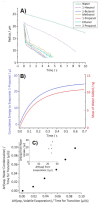Water Uptake by Evaporating pMDI Aerosol Prior to Inhalation Affects Both Regional and Total Deposition in the Respiratory System
- PMID: 34202458
- PMCID: PMC8309010
- DOI: 10.3390/pharmaceutics13070941
Water Uptake by Evaporating pMDI Aerosol Prior to Inhalation Affects Both Regional and Total Deposition in the Respiratory System
Abstract
As pulmonary drug deposition is a function of aerosol particle size distribution, it is critical that the dynamics of particle formation and maturation in pMDI sprays in the interim between generation and inhalation are fully understood. This paper presents an approach to measure the evaporative and condensational fluxes of volatile components and water from and to solution pMDI droplets following generation using a novel technique referred to as the Single Particle Electrodynamic Lung (SPEL). In doing so, evaporating aerosol droplets are shown capable of acting as condensation nuclei for water. Indeed, we show that the rapid vaporisation of volatile components from a volatile droplet is directly correlated to the volume of water taken up by condensation. Furthermore, a significant volume of water is shown to condense on droplets of a model pMDI formulation (hydrofluoroalkane (HFA), ethanol and glycerol) during evaporative droplet ageing, displaying a dramatic shift from a core composition of a volatile species to that of predominantly water (non-volatile glycerol remained in this case). This yields a droplet with a water activity of 0.98 at the instance of inhalation. The implications of these results on regional and total pulmonary drug deposition are explored using the International Commission of Radiological Protection (ICRP) deposition model, with an integrated semi-analytical treatment of hygroscopic growth. Through this, droplets with water activity of 0.98 upon inhalation are shown to produce markedly different dose deposition profiles to those with lower water activities at the point of inspiration.
Keywords: aerosol hygroscopic growth; deposition modelling; metered dose inhaler; spray plume aging; water condensation.
Conflict of interest statement
David Lewis is from Chiesi Farmaceutici S.p.A. The company contributed to the conceptualisation of the research problem, but had no role in the design of the study; in the collection, analyses, or interpretation of data; in the writing of the manuscript, or in the decision to publish the results.
Figures










Similar articles
-
Computational analyses of a pressurized metered dose inhaler and a new drug-aerosol targeting methodology.J Aerosol Med. 2007 Fall;20(3):294-309. doi: 10.1089/jam.2006.0617. J Aerosol Med. 2007. PMID: 17894536
-
Towards the bioequivalence of pressurised metered dose inhalers 1: design and characterisation of aerodynamically equivalent beclomethasone dipropionate inhalers with and without glycerol as a non-volatile excipient.Eur J Pharm Biopharm. 2014 Jan;86(1):31-7. doi: 10.1016/j.ejpb.2013.02.014. Epub 2013 Mar 21. Eur J Pharm Biopharm. 2014. PMID: 23523547
-
Flow Structure and Particle Deposition Analyses for Optimization of a Pressurized Metered Dose Inhaler (pMDI) in a Model of Tracheobronchial Airway.Eur J Pharm Sci. 2021 Sep 1;164:105911. doi: 10.1016/j.ejps.2021.105911. Epub 2021 Jun 12. Eur J Pharm Sci. 2021. PMID: 34129919
-
Principles of metered-dose inhaler design.Respir Care. 2005 Sep;50(9):1177-90. Respir Care. 2005. PMID: 16122401 Review.
-
Treatment of persistent asthma with Symbicort (budesonide/formoterol inhalation aerosol): an inhaled corticosteroid and long-acting beta2-adrenergic agonist in one pressurized metered-dose inhaler.J Asthma. 2010 May;47(4):447-59. doi: 10.3109/02770901003725684. J Asthma. 2010. PMID: 20528601 Review.
Cited by
-
In-vitro Evaluation of Solution Pressurised Metered Dose Inhaler Sprays with Low-GWP Propellants.Pharm Res. 2025 Feb;42(2):385-400. doi: 10.1007/s11095-025-03830-6. Epub 2025 Feb 12. Pharm Res. 2025. PMID: 39939559 Free PMC article.
-
Characterizing the Influence of Relative Humidity and Ethanol Content on the Dynamic Size Distributions of Aerosols Generated from a Soft Mist Inhaler.Pharm Res. 2025 Apr;42(4):651-663. doi: 10.1007/s11095-025-03851-1. Epub 2025 Apr 1. Pharm Res. 2025. PMID: 40169509 Free PMC article.
-
How to engineer aerosol particle properties and biopharmaceutical performance of propellant inhalers.Int J Pharm. 2023 Mar 5;634:122676. doi: 10.1016/j.ijpharm.2023.122676. Epub 2023 Feb 3. Int J Pharm. 2023. PMID: 36738807 Free PMC article.
-
In Silico Lung Deposition Profiles of Three Single-Inhaler Triple Therapies in Patients with COPD Using Functional Respiratory Imaging.Int J Chron Obstruct Pulmon Dis. 2025 Jun 27;20:2103-2116. doi: 10.2147/COPD.S510214. eCollection 2025. Int J Chron Obstruct Pulmon Dis. 2025. PMID: 40606813 Free PMC article.
-
Inhalable Nanotechnology-Based Drug Delivery Systems for the Treatment of Inflammatory Lung Diseases.Pharmaceutics. 2025 Jul 9;17(7):893. doi: 10.3390/pharmaceutics17070893. Pharmaceutics. 2025. PMID: 40733101 Free PMC article. Review.
References
-
- Newman S.P. Principles of metered-dose inhaler design. Respir. Care. 2005;50:1177–1190. - PubMed
Grants and funding
LinkOut - more resources
Full Text Sources
Medical
Research Materials

